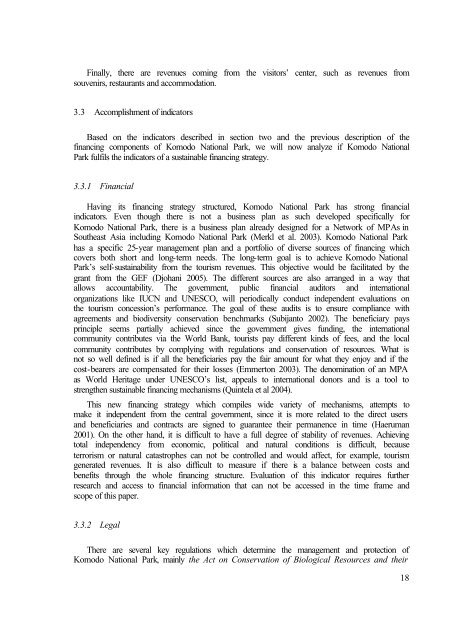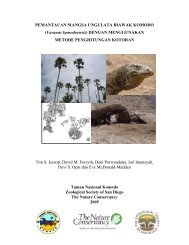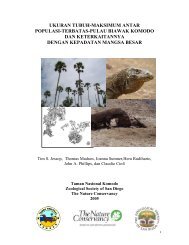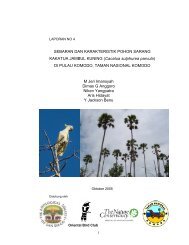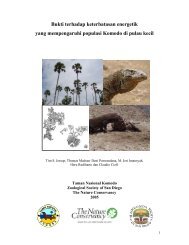Sustainable Financing of MPAs - Komodo National Park
Sustainable Financing of MPAs - Komodo National Park
Sustainable Financing of MPAs - Komodo National Park
You also want an ePaper? Increase the reach of your titles
YUMPU automatically turns print PDFs into web optimized ePapers that Google loves.
Finally, there are revenues coming from the visitors’ center, such as revenues from<br />
souvenirs, restaurants and accommodation.<br />
3.3 Accomplishment <strong>of</strong> indicators<br />
Based on the indicators described in section two and the previous description <strong>of</strong> the<br />
financing components <strong>of</strong> <strong>Komodo</strong> <strong>National</strong> <strong>Park</strong>, we will now analyze if <strong>Komodo</strong> <strong>National</strong><br />
<strong>Park</strong> fulfils the indicators <strong>of</strong> a sustainable financing strategy.<br />
3.3.1 Financial<br />
Having its financing strategy structured, <strong>Komodo</strong> <strong>National</strong> <strong>Park</strong> has strong financial<br />
indicators. Even though there is not a business plan as such developed specifically for<br />
<strong>Komodo</strong> <strong>National</strong> <strong>Park</strong>, there is a business plan already designed for a Network <strong>of</strong> <strong>MPAs</strong> in<br />
Southeast Asia including <strong>Komodo</strong> <strong>National</strong> <strong>Park</strong> (Merkl et al. 2003). <strong>Komodo</strong> <strong>National</strong> <strong>Park</strong><br />
has a specific 25-year management plan and a portfolio <strong>of</strong> diverse sources <strong>of</strong> financing which<br />
covers both short and long-term needs. The long-term goal is to achieve <strong>Komodo</strong> <strong>National</strong><br />
<strong>Park</strong>’s self-sustainability from the tourism revenues. This objective would be facilitated by the<br />
grant from the GEF (Djohani 2005). The different sources are also arranged in a way that<br />
allows accountability. The government, public financial auditors and international<br />
organizations like IUCN and UNESCO, will periodically conduct independent evaluations on<br />
the tourism concession’s performance. The goal <strong>of</strong> these audits is to ensure compliance with<br />
agreements and biodiversity conservation benchmarks (Subijanto 2002). The beneficiary pays<br />
principle seems partially achieved since the government gives funding, the international<br />
community contributes via the World Bank, tourists pay different kinds <strong>of</strong> fees, and the local<br />
community contributes by complying with regulations and conservation <strong>of</strong> resources. What is<br />
not so well defined is if all the beneficiaries pay the fair amount for what they enjoy and if the<br />
cost-bearers are compensated for their losses (Emmerton 2003). The denomination <strong>of</strong> an MPA<br />
as World Heritage under UNESCO’s list, appeals to international donors and is a tool to<br />
strengthen sustainable financing mechanisms (Quintela et al 2004).<br />
This new financing strategy which compiles wide variety <strong>of</strong> mechanisms, attempts to<br />
make it independent from the central government, since it is more related to the direct users<br />
and beneficiaries and contracts are signed to guarantee their permanence in time (Haeruman<br />
2001). On the other hand, it is difficult to have a full degree <strong>of</strong> stability <strong>of</strong> revenues. Achieving<br />
total independency from economic, political and natural conditions is difficult, because<br />
terrorism or natural catastrophes can not be controlled and would affect, for example, tourism<br />
generated revenues. It is also difficult to measure if there is a balance between costs and<br />
benefits through the whole financing structure. Evaluation <strong>of</strong> this indicator requires further<br />
research and access to financial information that can not be accessed in the time frame and<br />
scope <strong>of</strong> this paper.<br />
3.3.2 Legal<br />
There are several key regulations which determine the management and protection <strong>of</strong><br />
<strong>Komodo</strong> <strong>National</strong> <strong>Park</strong>, mainly the Act on Conservation <strong>of</strong> Biological Resources and their<br />
18


